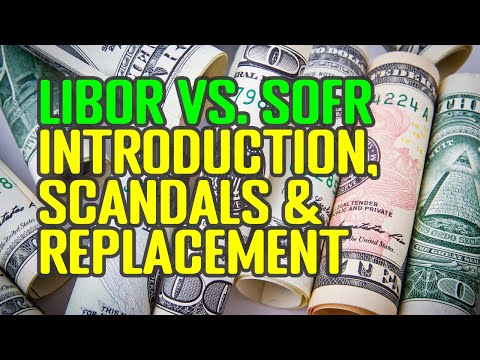Navigating the ever-shifting landscape of mortgage rates can seem like a daunting task, but fear not, because we’re about to embark on a journey through the transition from LIBOR vs SOFR and what it means for your loans. With an educational nod to the financial wisdom of Suze Orman and the practical prowess of Robert Kiyosaki, let’s unravel this tapestry of fiscal change.

Deciphering the Shift from LIBOR to SOFR: What It Means for Your Loans
Have you ever wondered why financial institutions are bidding farewell to LIBOR and cozying up with SOFR? Let’s dive into the nitty-gritty of this switcheroo!

Understanding the Basics: 1 Month LIBOR Rate and Its Role in Lending
Let’s rewind a bit and talk about the LIBOR rate—specifically the 1 month LIBOR rate—that has been a cornerstone in the lending world for years.

| Feature | LIBOR (London Interbank Offered Rate) | SOFR (Secured Overnight Financing Rate) |
|---|---|---|
| Description | An interest rate benchmark based on the rates banks charge each other for short-term loans. | A rate based on actual transactions in the Treasury repurchase market, representing the cost of borrowing cash overnight collateralized by U.S. Treasury securities. |
| Calculation Basis | Based on submissions by participating panel banks estimating their own borrowing costs. | Derived from a broad set of actual transactions from the U.S. Treasury repurchase agreements (repos), making it a transaction-based rate. |
| Security | Unsecured; more susceptible to manipulation due to its dependency on estimates rather than transactions. | Secured; less vulnerable because it is based on completed transactions in a highly liquid market. |
| Implementation | Historically used worldwide for various financial products including mortgages, loans, and derivatives. | Introduced to replace LIBOR as a more reliable and robust benchmark for financial products. |
| Transition | Ceased for US dollar LIBOR panel on July 3, 2023. | Being adopted across financial markets as the primary replacement for LIBOR. |
| Post-Cease Date | Synthetic LIBOR settings to cease at the end of September 2024. | Continues to serve as the recommended benchmark for new contracts. |
| Volatility | Could be more volatile as it reflects banks’ credit risk and lending conditions. | Typically less volatile with its foundation on the secure, and typically stable, U.S. Treasury repurchase agreements. |
| Adoption | Previously entrenched in financial systems globally but is now being phased out. | Increasing adoption as markets transition from LIBOR, supported by the Federal Reserve and other institutions. |
| Rate Adjustments | Updated daily at 11:45 a.m. (London time) for various maturities (overnight to 12 months). | Published each business day at approximately 8:00 a.m. ET, reflecting the cost of borrowing overnight. |
| Risk Sensitivity | Higher due to inclusion of bank credit risk premium and other factors. | Lower risk sensitivity, primarily reflecting U.S. Treasury securities’ rates and the Federal Reserve’s monetary policy. |
| Reliability and Future Use | Decreased reliability leading up to its discontinuation due to decreased use and submissions by banks. | Expected to remain stable and reliable due to its basis on actual transactions in a liquid market. |
SOFR vs LIBOR: Unveiling the New Benchmark for Your Loans
Move over, LIBOR—there’s a new kid on the block. Get up close and personal with SOFR, the choice pick for your loans going forward.

Real-World Impact: How the Transition to SOFR Affects Loan Contracts and Mortgages
When it comes to the nitty-gritty of your loan agreements, things are going to get a tad more interesting.

SOFR Over LIBOR: Potential Advantages and Disadvantages for Borrowers
If you’re wringing your hands, wondering if SOFR spells doom or bloom for your wallet, let’s weigh the pros and cons.
Navigating Your Loan Options: Expert Strategies in the LIBOR vs SOFR Era
Ready to chart your course in the brave new world of SOFR? You will need some pro tips up your sleeve.
Transitional Tales: How Lenders and Markets are Adapting to the SOFR Standard
The shift from LIBOR to SOFR isn’t just a footnote in financial history—it’s a full-blown chapter revision.
The Long-Term Horizon: Predicting the Evolving Dynamics Between LIBOR and SOFR
Now, looking into the financial crystal ball, let’s ponder what the landscape may look like once LIBOR rides off into the sunset.
Crafting a New Benchmark Blueprint: Critical Insights on SOFR’s Influence on Lending
It’s time to put on our thinking caps and dig deep into the transformational power of SOFR.
Borrowing in a Post-LIBOR World: What It Actually Means for You
Down to brass tacks—how will swapping LIBOR for SOFR shake up your own financial picture?
Reflecting on a New Financial Chapter: The LIBOR-SOFR Transition Unraveled
Let’s tie it all together, shall we? A farewell to LIBOR, a hello to SOFR, and what this grand transition heralds.

What is the main difference between LIBOR and SOFR?
Sure! Here are the answers to the FAQs:
Why is LIBOR being replaced by SOFR?
What is the main difference between LIBOR and SOFR?
Wowza, the main difference is pretty big! LIBOR is like a chatty neighbor, gossiping about the interest rates banks charge each other for loans, while SOFR is like your quiet buddy who only watches what’s actually going down in the Treasury repurchase market. To put it simply, LIBOR is based on bank-reported estimates, and SOFR relies on actual transactions.
Is LIBOR still used in 2023?
Why is LIBOR being replaced by SOFR?
Well, shake things up! LIBOR’s getting the old heave-ho because it had a bit of a scandal problem, with some naughty manipulation by banks. Enter SOFR, the new kid on the block, known for its reliability and transparency since it’s based on real-life, cold-hard-cash transactions in the U.S. Treasury market.
What are SOFR rates used for?
Is LIBOR still used in 2023?
Hang onto your hats! As of 2023, LIBOR’s been largely benched, especially for new contracts, but don’t be surprised if you spot it here and there, like dinosaur fossils, in some existing contracts lingering around until they expire.
What are the disadvantages of SOFR?
What are SOFR rates used for?
Well, SOFR’s the new sheriff in town, setting its sights on all sorts of stuff, from mortgages to business loans. It’s kinda like the base seasoning in the lending world, giving the dough its rise in a whole pantry full of financial products.
What are the advantages of SOFR vs LIBOR?
What are the disadvantages of SOFR?
Hold your horses! SOFR isn’t all rainbows and butterflies. Its main downside is the lack of a forward-looking term structure, making it tough to guess tomorrow’s weather in rate terms. Plus, it can swing more than a pendulum because it’s tied to the Treasury repo market, which can get jittery during financial kerfuffles.
What is the issue with SOFR?
What are the advantages of SOFR vs LIBOR?
Well, let’s dish the dirt: SOFR’s solid ’cause it’s built on heaps of real-deal transactions, making it tough to rig, unlike LIBOR, which was more of a ballpark guess. Plus, SOFR’s transparency is crystal clear, giving it the good kind of street cred in the finance ‘hood.
What is the current SOFR rate today?
What is the issue with SOFR?
Heads up, folks! The trouble with SOFR is that it’s like an awkward teenager — it doesn’t always handle stress well because it can get jumpy in times of financial drama, and it also hasn’t grown into its forward-looking shoes yet, making it less predictable for long-term planning.
Is SOFR replacing USD LIBOR?
What is the current SOFR rate today?
Ah, you’re hunting for today’s SOFR rate, huh? Well, those numbers are like the daily special — constantly changing. Your best bet? Check out the latest deets from the Federal Reserve Bank of New York for the hot-off-the-press rates.
Does USD LIBOR still exist?
Is SOFR replacing USD LIBOR?
You betcha! SOFR’s taking over from USD LIBOR like a runner passing the baton in a relay race. The financial world’s phasing out the old-school LIBOR for the shiny new SOFR in U.S. dollar transactions.
Does anyone still use LIBOR?
Does USD LIBOR still exist?
Yep, USD LIBOR’s still kicking around, but it’s on the way out like VCRs and floppy disks. It’s living on borrowed time, with most of its use in the rearview mirror.
What happens to LIBOR after June 2023?
Does anyone still use LIBOR?
Well, believe it or not, a few stragglers are still clinging to LIBOR like a trusty old blanket, mostly in existing contracts. But as for new agreements? LIBOR’s pretty much been shown the door.
What are the 4 types of SOFR?
What happens to LIBOR after June 2023?
After June 2023, it’s curtains for LIBOR! This once go-to rate will stop being published for most currencies. It’ll be like it’s retired to Florida — out of the limelight and no longer the main character in our financial stories.
Why are we switching to SOFR?
What are the 4 types of SOFR?
So there’s a quartet of SOFR flavors: the in-and-outer overnight rate, the smooth and steady cumulative rate, the averaged rate that likes to spread out, and the term rate, which offers a sneak peek into expected future rates. Each one’s cooking up its own style of interest seasoning!
Why is SOFR considered risk free?
Why are we switching to SOFR?
Switcheroo to SOFR is happening because it’s seen as more reliable, thanks to its base in actual transactions. It’s like swapping out a wonky compass for a GPS — it guides you right because it knows where it’s going, without any funny business.
Why are we switching to SOFR?
Why is SOFR considered risk free?
Now, when they say SOFR is “risk-free,” they mean it’s taking a safer route, away from credit risk, not hitching a hike with Banks’ estimations, but carpooling with the Treasury repo rates.
Is there a credit risk premium for SOFR?
Is there a credit risk premium for SOFR?
No siree, SOFR steers clear of the credit risk premium. It’s as if it’s insured against the ups and downs of banks’ borrowing blues — it doesn’t sweat over bank credit conditions.
Why is LIBOR so popular?
Why is LIBOR so popular?
LIBOR was like the cool kid everyone wanted to hang with — it was the benchmark for a massive chunk of the global financial system. It was super convenient, but hey, even popular kids have their secrets, and LIBOR’s got a scandalous past.
What is the current SOFR rate?
What is the current SOFR rate?
I do declare, you’re like a detective on the case of the ever-changing SOFR rate! It’s an everyday chameleon, so you’ll want an up-to-date briefing from the New York Fed’s site to get your hands on the fresh numbers.



